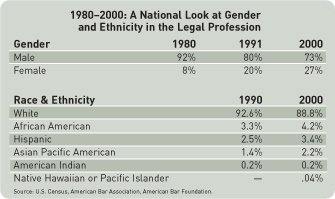(Continued...) Back to Page 1
In the four-plus years since the
signing of the initiative, the percentage
of diverse attorneys in the participant
firms has climbed steadily. A study
of a KCMBA sample among the Diversity
Initiative signatories points to a
higher percentage of female lawyers
in Kansas City, up to nearly 30 percent
in 2007 from 27.6 percent three years
prior, and a higher percentage of African
American lawyers as well, up to 2.5
percent in 2007 from 1.8 percent in
2004. Considering that these numbers
are derived from a cooperative sample
of signatories, however, Kansas City still
has challenges ahead. And although
these figures indicate consistent, positive
growth, they are are less than
the national figures. Of approximately
1,001,000 lawyers practicing in the
United States in 2007, 32.6 percent
were women, 4.9 percent were African
American and 4.3 percent were Hispanic
or Latino, according to the U.S. Census.
Given the ever-changing, ever-evolving
legal profession, the Diversity Initiative
continues to influence strategic
plans to move diversity forward in Kansas
City. While its signing may have represented
an early effort to implement
diversity, the document continues to
have an impact. “In law firms across the
city, whether they are large, medium or
small, they are paying more attention to
all of our efforts with respect to diversity,”
says Epps. These days, the question in
law firms is not so much whether diversity
initiatives should be implemented,
but how they should be implemented. “I
think people are becoming more open
to the concept of diversity,” comments
James. “In short, there is a greater awareness,
a concentrated focus on it. The
managing partners of the law firms are
involved in pushing this effort, so there
is a top-down leadership going on.”
In the future, those involved hope
that the issue of diversity will cease to
be an “issue” and that diverse workforces
will emerge as a natural part of the
company culture.![]()

Ingram’s devoted its 2007 Legal
Industry Outlook to the issue of diversity
in Kansas City law firms.
Sponsored and hosted by Shook, Hardy & Bacon, the assembly attracted representatives
from the Kansas City
Metropolitan Bar Association, area
law schools and law firms. The participants,
several of whom were diversity
partners at their respective firms,
agreed that the issue of diversity
was a challenge in both Kansas City
and across the nation. In addition
to the approaches outlined in the
KCMBA Diversity Initiative, participants
mentioned other strategies
to recruit diverse candidates, “beyondthe-
box credentials,” for example.
Many had attended and spoke highly
of the KCMBA Diversity Job Fair.
The meeting concluded with the
understanding that the implementation
of diversity would require an
agreement between schools, legal
associations, and law firms of all
sizes. These and other initiatives are
changing the face of the legal profession
around the country.![]()

